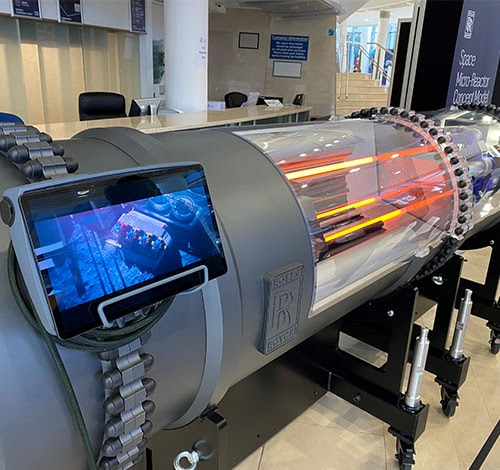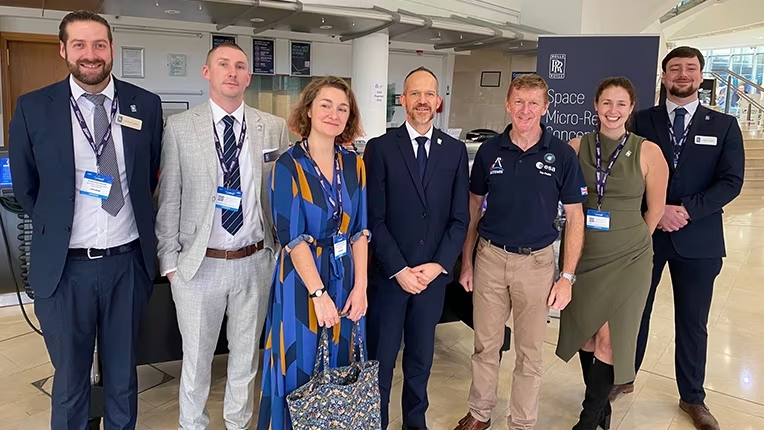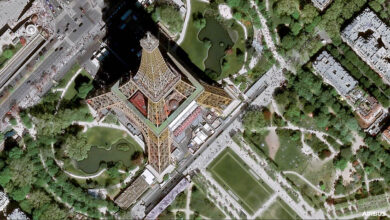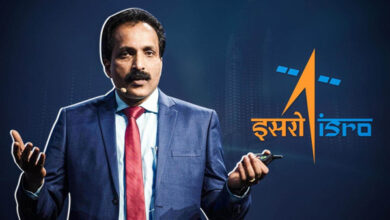Rolls-Royce unveils Space Micro-Reactor model for Moon exploration
UK, December 1. Rolls-Royce unveiled a nuclear Space Micro-Reactor Concept Model at the UK Space Conference in Belfast last week. It is part of the UK Space Agency backed research programme to deliver an initial demonstration of a UK lunar modular nuclear reactor.

The UK Space Conference was the ideal place to reveal the Micro-Reactor model, which generated cross-industry interest – including a visit from European Space Agency Astronaut, Major Tim Peake. The Rolls-Royce Novel Nuclear team were delighted to talk Tim through the model and the applications of our technology in Space.
In March 2023, Rolls-Royce secured funding of £2.9m from UK Space Agency, backing our research into how nuclear power could be used to support a future Moon base for astronauts. The technologies presented at the UK Space Conference are the culmination of this year’s research.
Scientists and engineers at Rolls-Royce, alongside strategic partners, have been working on several work packages under the UK Space Agency funded programme, to further strengthen its knowledge of these complex systems. The work packages have specifically focused on three key features of the Micro-Reactor; the fuel used to generate heat, the method of heat transfer and technology to convert that heat into electricity.
All space missions depend on a power source and, as a self-contained and power-dense solution, a Micro-Reactor can provide power for the habitation and exploration of a planetary surface, or power and propulsion for spacecraft. Continuous power and efficient propulsion can also provide satellites with more flexible movement to protect and defend key orbits.
Relatively small and lightweight compared to other power systems, a nuclear Micro-Reactor could enable continuous power regardless of location, available sunlight, and other environmental conditions. Rolls-Royce plan to have a reactor ready to send to the Moon by the early 2030s.
Rolls-Royce has worked alongside a variety of collaborators including the University of Oxford, Bangor University, Loughborough University, The Welding Institute and the Nuclear Advanced Manufacturing Research Centre (NAMRC).
The potential applications of Rolls-Royce Micro-Reactor technology are wide-ranging and could support commercial and defence use cases in addition to those in space. The aim is to create a world-leading power and propulsion capability for multiple markets and operator needs, which also supports global net zero targets.
Abi Clayton, Director of Future Programmes for Rolls-Royce said: “The funding from UK Space Agency has allowed the Rolls-Royce Micro-Reactor programme to work collaboratively with the UK Space Agency, UK academic institutions and industry partners to showcase the best of UK innovation and knowledge in space.
“This funding has enabled crucial research and development of technologies that bring us closer to making the Micro-Reactor a reality. Our Space Micro-Reactor Concept Model allows us to demonstrate how this technology will bring immense benefits for both space and Earth.
“Micro-Reactor technology will deliver the capability to support commercial and defence use cases alongside providing a solution to decarbonise industry and provide clean, safe and reliable energy.”

Dr Paul Bate, Chief Executive of the UK Space Agency, said: “We are backing technology and capabilities to support ambitious space exploration missions and boost sector growth across the UK. Developing space nuclear power offers a unique chance to support innovative technologies and grow our nuclear, science and space engineering skills base.
“This innovative research by Rolls-Royce could lay the groundwork for powering continuous human presence on the Moon, while enhancing the wider UK space sector, creating jobs and generating further investment.”
The partnership with Rolls-Royce comes after the UK Space Agency recently announced £51 million of funding available for UK companies to develop communication and navigation services for missions to the Moon, as part of the European Space Agency’s Moonlight programme, which aims to launch a constellation of satellites into orbit around the Moon.
This will allow future astronauts, rovers, science experiments and other equipment to communicate, share large amounts of data including high-definition video, and navigate safely across the lunar surface.





